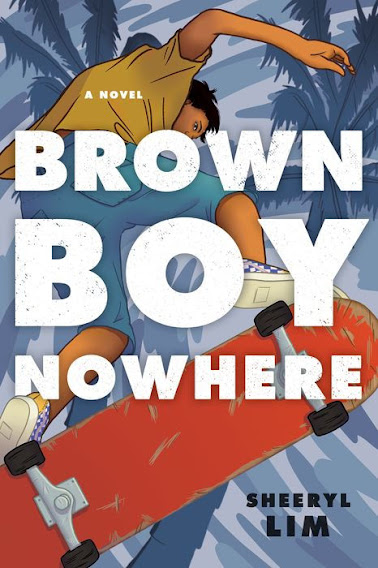Some books don't just tell a story -- they echo your own. Brown Boy Nowhere by Sheeryl Lim struck a deep chord with me as a Filipino American navigating questions of identity and belonging. This young adult novel reflects the Filipino diaspora experience with honesty and nuance, exploring themes of cultural disconnection, assimilation, the ache of feeling out of place, and the quiet resilience of diaspora youth. Through Angelo’s journey, Brown Boy Nowhere invites readers to reflect on what it means to hold onto one’s heritage while navigating the pressures of belonging in the U.S. Author Sheeryl Lim crafts a narrative that's both personal and powerful. It’s a powerful reminder that even in the midst of displacement, our culture can still be reclaimed, preserved, and celebrated.
Brown Boy Nowhere by Sheeryl Lim
August 1, 2021 from Skyscape
What’s the problem? Sixteen-year-old Filipino American Angelo Rivera will tell you flat out. Life sucks. He’s been uprooted from his San Diego home to a boring landlocked town in the middle of nowhere. Behind him, ocean waves, his girlfriend, and the biggest skateboarding competition on the California coast. Ahead, flipping burgers at his parents’ new diner and, as the only Asian in his all-white school, being trolled as “brown boy” by small-minded, thick-necked jocks.Resigned to being an outcast, Angelo isn’t alone. Kirsten, a crushable ex-cheerleader and graffiti artist, and Larry, a self-proclaimed invisible band geek, recognize a fellow outsider. Soon enough, Angelo finds himself the leader of their group of misfits. They may be low on the high school food chain, but they’re determined to hold their own.Between shifts at the diner, dodging bullies, and wishing for home, Angelo discovers this might not be nowhere after all. Sharing it can turn it into somewhere in a heartbeat.
Reflection Notes from Brown Boy Nowhere
I deeply appreciate that this story centers a Filipino American protagonist, Angelo, who is uprooted from his familiar life and close friendships after his family relocates. The book insightfully explores the challenges many Filipino Americans face—racism, cultural displacement, and identity struggles—without making these hardships the sole defining element of the plot.
As a Filipino American myself who was born and raised in the diverse Bay Area of California, Angelo’s experience resonated in me deeply. When my own family moved to a predominantly white town up north, I faced many of the same challenges: racism, cultural isolation, and the pressures to conform here. These experiences, unfortunately, are not uncommon within the Filipino diaspora. The tension and culture shock of adapting to a new environment while holding onto our identity is something many of us understand all too well.
The book authentically captures the internal conflict of navigating two worlds. From subtle microaggressions to overt discrimination, from invisibility in mainstream media to the burden of assimilation, Filipino Americans often find themselves straddling cultures, never fully embraced by either. Yet, amid the struggle, there is also hope and joy. Angelo’s connection with other marginalized kids in his new community—people who accept him fully—becomes a source of healing and belonging. Reading about his found family reminded me of my own journey and the joy of being seen and accepted for who I am, and for other Fil-Am's going through acceptance as well.
What stood out the most was watching Angelo grow into his dual identity, embracing both his American life and his Filipino roots. It made my heart smile to see that journey toward wholeness—a reminder that reclaiming heritage can be both grounding and liberating.
This novel beautifully captures the nuances of the Filipino American experience that will resonate deeply with many Fil-Am's who have lived/are living through similar realities as Angelo: the pain, the resilience, and the triumphs. It acknowledges the privileges of growing up in the U.S., while also revealing that the privilege often comes with a heavy cost.
I also love that this story doesn’t focus solely on hardship. It challenges stereotypes placed on us and highlights both the complexity and richness of our identity. It opens a window not just for Filipino Americans, but also for white Americans and Filipinos in the Philippines, inviting a deeper understanding of the layered lives we lead here. In doing so, it celebrates the beauty of carrying both Filipino and American identities—an experience marked by struggle, yes, but also by strength, pride, and joy.
Assimilation and Identity Struggles
Navigating Cultural Duality: Angelo's journey from San Diego, CA to a small town in Texas illustrates the complexities of maintaining one's cultural identity amidst pressures to assimilate. The move to a predominantly white town highlights the challenges faced by Filipino immigrants and their descendants in balancing their heritage with the desire to fit into the idealized American society that Americans wants us to embody while living here.
Generational Perspectives on Assimilation: Filipino parents often prioritize English proficiency over teaching their native language (due to American schooling and society being solely English centered for a long time) at the expense of passing down the language and traditions, leading to a gradual erosion of cultural ties. This generational shift can result in younger Filipino diaspora feeling disconnected from their roots, as they lack the linguistic and cultural tools to fully engage with their Filipino heritage.
Cultural Displacement and Alienation from both heritage
Cultural Disconnection: Angelo’s lack of strong ties to Filipino customs and language reflects a broader phenomenon in second-generation immigrant families. This loss can feel like a quiet ache—exacerbated by guilt from Filipinos in the Philippines. Angelo's journey of acceptance feels like a healing balm to the soul.
Experiencing Racial Prejudice: The racism Angelo endures—being called “brown boy,” for example—reflect the broader reality many Filipino Americans face: being treated as perpetual outsiders in both of our ancestral and adopted cultures. This alienation is not just societal, but internal as well. The Philippines itself can feel distant or unfamiliar to second and third-gen Filipino diaspora, deepening the sense of not fully belonging anywhere.
Psychological Impact of Displacement: The sense of alienation is compounded by the physical and psychological distances from the Philippines. Immigrants often experience a longing for a homeland that has evolved without them, intensifying feelings of displacement and identity confusion.
Reclaiming our Filipino heritage
Community and Cultural Reclamation: The novel also points toward healing: Angelo’s story reminds us that reclaiming our identity is possible, especially now that cultural resources are more accessible than ever before. It also shows how solidarity among marginalized individuals can serve as a lifeline. Angelo’s friendships become a means of reclaiming identity and joy. Through community, we begin to rebuild what was once lost. We owe it to ourselves to explore and embrace it.
In conclusion, Brown Boy Nowhere is more than a coming-of-age story—it’s a mirror for many of us in the diaspora. It’s a testament to the complexity of being Filipino American: the duality, the pain, the healing, and the triumphs of identity rediscovered. Author Sheeryl Lim has crafted a story that feels like a gift to the Filipino American community. She captures the complexities of our identity with honesty, care, and nuance—highlighting both the pain and the beauty of living between cultures. This book felt like a balm for my soul, and I’m deeply grateful for the way Lim put words to experiences so many of us carry in silence. I hope other Filipino Americans will find this story too, and that it offers them the same healing, validation, and hope it gave me.
Brown Boy Nowhere Discussions
🌱 How does Angelo's struggle with his Filipino heritage and his limited fluency in Tagalog reflect the experiences of many second and third-generation immigrants?
🌱 How can we strengthen community ties among Filipinos in the diaspora, creating networks of support that bridge generational and cultural gaps?
🌱 What does the novel suggest about the balance between adapting to a new environment and preserving one's cultural identity?
🌱 In what ways does the novel portray the power of youth activism in challenging societal norms and advocating for change?











Social Icons